Saturday, May 17, 2008
No. 144 - 2054 Griffin Avenue Residence
2054 Griffin Avenue Residence
c. 1887
2054 Griffin Avenue, Lincoln Heights – map
Declared: 5/21/75
This masonry Victorian house in Lincoln Heights is one of the oldest in the community. The street on which it sits is named for Dr J.S. Griffin, “The Father of East Los Angeles.”
John Strother Griffin was born in Fincastle, Virginia, in 1816. Raised in Louisville, Kentucky, he went to med school at the University of Pennsylvania, and became a doctor in the U.S. Army. As head surgeon for Gen. Stephen Kearny, he not only tended to the injured in the battle of San Pascual in December 1846, he also was on hand for the American capture of the city of Los Angeles the following month. (Buy his diary of his Mexican War experience here.) He returned to settle in L.A. in 1854.
Griffin was interested not only in education – in 1856 he was elected superintendent of the first public school in L.A. – but also in educators – he married Louisa Hayes, the city’s first female public-school teacher. With Prudent Beaudry and Solomon Lazard, he set up the Los Angeles Water Company, obtaining a thirty-year lease to oversee the city’s water system beginning in 1868 (he built the first irrigation ditch taking water from the Arroyo Seco to water the region). Griffin was the first president of the County Medical Society (1871) and served as a director on the city’s first Chamber of Commerce, then known as the Board of Trade (1873). (A lot of firsts in this paragraph. - ed.)
One of L.A.’s early physicians, he bought up land like nobody’s business throughout the 1860s, including two thousand acres in East L.A. in 1863 for fifty cents an acre. In 1873 he sold 4,000 acres of Rancho San Pascual (which he had bought from Don Manuel Garfias some fifteen years earlier) to an organization from Indiana which renamed the land Pasadena.
With his nephew, Hancock Johnston, Griffin laid out and planned the streets of East Los Angeles, selling the land little by little. (It’s ironic a large chunk of his old property is Lincoln Heights. According to Harris Newmark, Griffin was a staunch Southerner who lost his senses cheering Abraham Lincoln’s assassination in 1865.)
Dr Griffin spent many years living on Main Street between First and Second, but died in his home at 1109 Downey Avenue, now North Broadway, on August 23, 1898.
This landmark was built around 1887. Various city directories list residents Joseph and Rosina Thompson and Pearl Treon (1936) and osteopathic physician C.E. Broadhead (1939). Walter H. Klapper owned the house during its designation in 1975, and architect Bruce Boehner and his wife, Gloria, soon after purchased the home with plans to restore it.
It looks to be in great shape today, but I can’t figure out what that solitary second-story window on the north side indicates in terms of the floor’s layout. It looks original to the building’s design, too.
Sources:
“Founder of Cities.” Los Angeles Times; Aug 24, 1898, p. 11
Newmark, Harris. Sixty Years in Southern California Houghton Mifflin Company 1930 Boston and New York
Up next: 3537 Griffin Avenue Residence
Posted by
Floyd B. Bariscale
at
10:48 PM
![]()
Labels: Northeast Los Angeles
Subscribe to:
Post Comments (Atom)
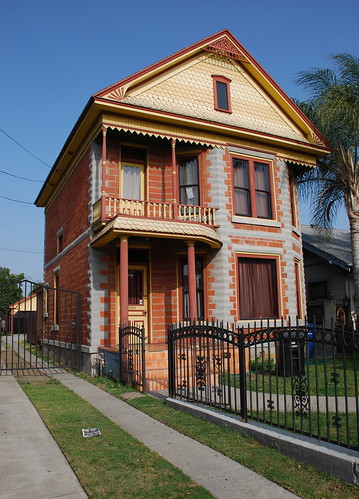
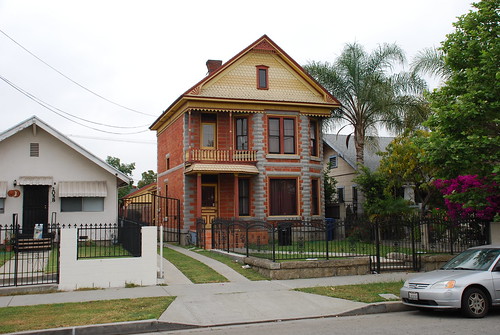
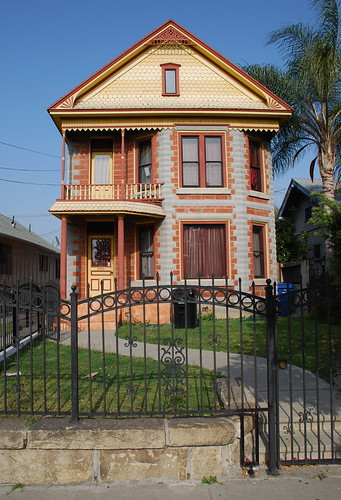
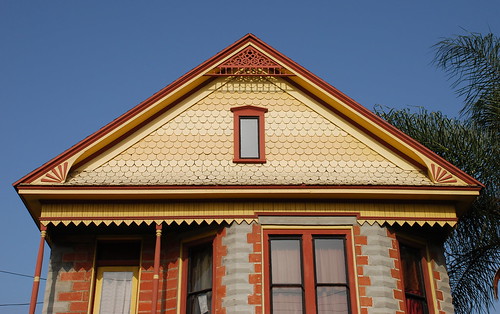
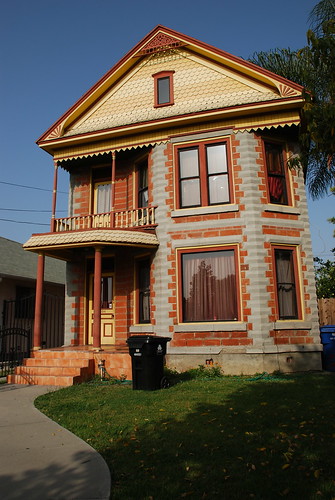
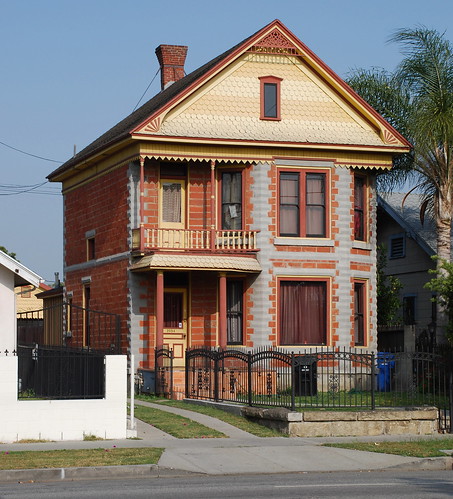

10 comments:
That is a strange little window up there amongst the fishscale shingle…I suspect that’s where they keep the crazy aunt, or deformed son, or something equally cinematic, who in the crash of lightning can be seen cackling manically.
I took a look at the old photo on the City Planning HCM list and was shocked to see what had happened to Griffin’s neighbor at 2058…ooch. Nice enclosed porch and acres of stucco. Ok, well shocked isn’t the right word. In fact I’d be surprised if they didn’t. The bane of this part of the world.
I drive Griffin all the time and never knew he was an old Unreconstructed…check out the Robert E. Lee beard. And a Virginian yet, like Jefferson, Washington, Monroe, Madison, and, uh, Robert E. Lee. Let’s understand Griffin’s Lincoln cheers in their historical context. There was a time when Honest Abe wasn’t so deified. I mean, Lincoln didn’t fight the war to free slaves (he [uh, slaveowner, btw] didn’t even free them in Kentucky) so that argument about sainthood is out—and he was a pretty nasty guy—he nixed freedom of the press, imprisoned political opponents and war protesters, suspended the writ of habeas corpus, etc. (Of course no-one mentions Lincoln’s armies and their slaughter of Native Americans, e.g. the Sand Creek Massacre.) Not to say that Lincoln wasn’t a just and vocal opponent of slavery—Frederick Douglas was a fan of his even before the election. (We also shouldn’t assume that Griffin was pro-slavery, either.) But the war? Until a historical rewrite it was for decades generally held by north and south that the blood of 600,000+ men was on Lincoln’s hands, a war he started to keep power away from Seward and Chase, who were sort of the Dick and Rummy of their day. (Read Lincoln’s first inauguration speech; in it, he lies to get us into war. Yeah, there’s a lot of comparisons to be made between then and now. But then, this isn’t that sort of blog, my apologies. Let’s get back to fishscale shingle.)
At least the residents of Griffin will be mighty perplexed when I drive by and whoop a Bo and Luke Duke “Yee-Haw” at the house.
Oh, not the front window among the shingles. I'm talking about the one around the corner (you can't see it too well in these shots). I thought it went without saying the front one was for the crazy/deformed aunt/son.
I agree about the neighbor. For what it's worth the house on the south side appears mainly original.
From lincolnheightsla.com, this excerpt would go a long way explaining why Griffin was pro Jeff Davis:
"In addition to his brother-in-law being Confederate General Albert Sydney Johnston, the #2 ranking general in 1862 (ahead of even Robert E. Lee at that time), Griffin's uncle was William Clark (of Lewis and Clark). On the Strother side Griffin was also related to General (later Pres.) Zachary Taylor, and thus to Jefferson Davis (whose first wife was Taylor's daughter, Sarah). Through Strothers he was also related to Pres. John Tyler."
you guys are funny
You mean the small window above the brick belt course? Looks like a window that would be just above the landing in the stair hall.
That's what I thought at first, but then there's the tall first floor window right beneath it - that would be right under the landing. Maybe it's the lack of any other windows up there that throws me. You're probably right, though. I just have trouble imagining it.
Would you by chance have any information about houses still in existence on Griffin Ave from 1882? I have letters written from LA at this time, but they don't show a street address. They are family letters from the house where I run a B&B in Fulton, MO. Thanks for any help you might be able to offer.
Hi, Electra. I can't say how many Griffin Avenue homes date to 1882, but I'd be surprised if any did. I would search the L.A. Public Library's city directories, dating back to 1872. There's a good chance, though, you may not find house numbers there, either, but if the family lived on Griffin much later than 1882, the numbers may start to pop up. Good luck.
I don't even know how I stumbled upon this blog but I LOVE IT! I sure hope you continue posting.
Yes, I hadnt noticed how that window looked from the outside. I can assure everybody that it is part of the staircase. It is almost at the top of the staircase.
In regards to the crazy family member living in the attic, maybe.... I personally have not gone up since I bought the house.
I used to live in this house circa 1992-93 (Boehner was my landlord), and I don't recall the two lower windows on the north side at all! I recall that whole lower part of the north wall being solid. Cool house with interesting spaces inside and out.
Post a Comment